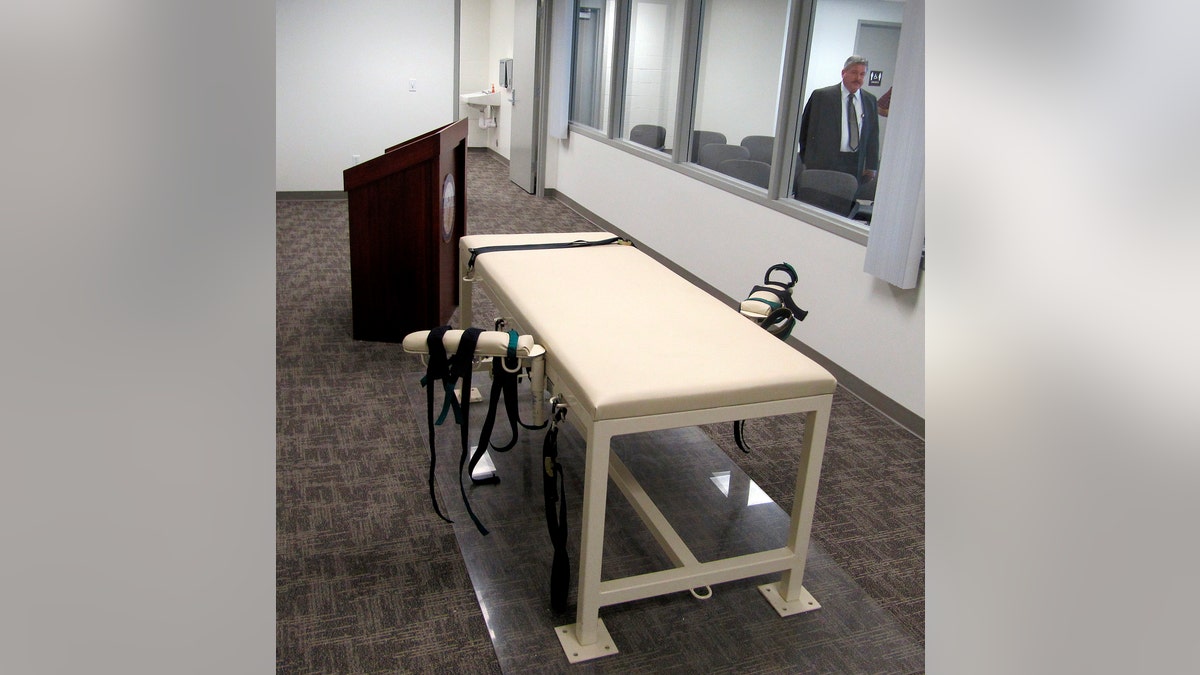Convicted Idaho serial killer Thomas Eugene Creech survived his scheduled execution last month when his executioners spent an hour trying to find a suitable vein and failed.
He is one of the country’s longest-serving death row inmates, and he’s been sentenced to death more than once, although his latest death warrant has now expired, and authorities are considering their next move.
Fordham Law School Professor Deborah Denno, a leading expert on capital punishment, explained that lethal injection has become less reliable over the years with production of a key drug no longer conducted on American soil.
She added that the death penalty is better delivered by the time-tested firing squad over new methods like Alabama’s nitrogen hypoxia process, which resulted in a gruesome scene during its first use in January.
Inset: Mugshot of condemned murderer Thomas Creech. Background: The sun rises on the entrance to the Idaho State prison complex near Kuna, Idaho, Wednesday, Feb. 28, 2024. (AP Photo/Kyle Green, Inset: Idaho Department of Correction)
“The elephant in the room is this has happened so many times. Why weren’t they more prepared?” Denno told Fox News Digital.
There is secrecy surrounding training for such executions and the medical staffs that conduct them, she said. But while there could be more transparency there, and the credentials of the executioners could be presented in substance without sacrificing their anonymity, there is a simpler option.
There’s no shortage of trained marksmen who could take part in a firing squad from 20 yards away, and the method has proven reliable over the centuries.
Creech is the fourth condemned inmate to survive his scheduled lethal injection in just a few years, she said. The method spiraled into chaos after 2009, when the last U.S. manufacturer of one of three drugs closed down, making it difficult for states to obtain, especially since its leading manufacturer, an Italy-based company, opposes the death penalty.
IDAHO GOVERNOR SIGNS LAW ALLOWING FIRING SQUAD EXECUTIONS
“The elephant in the room is this has happened so many times. Why weren’t they more prepared?”
Substitutions have shown poor results, Denno said. And she has concerns about the training for people who administer the drugs, which can be shrouded in secrecy.
“We have every detail on the last meal that these inmates eat. There are articles written down to how many packets of ketchup they use,” she said. “And we just don’t have any details on the actual execution process, but they certainly could be provided while protecting people’s anonymity. And I do think drug companies should be known. We should know where the drugs are coming from.”
That’s why, she says, Idaho’s recently revived firing squad is the most effective method for capital punishment.

A prison officer patrols near the Idaho State prison complex near Kuna, Idaho, Wednesday, Feb. 28, 2024. (AP Photo/Kyle Green)
“We’ve had three modern firing squad executions, and they have gone off as intended, and the inmate has died quickly and with dignity,” she said. “So, I think that is something to emphasize.”
She pointed to Alabama’s recent experiment with nitrogen hypoxia. Kenneth Smith, a hitman convicted of a 1988 murder for hire, was the first person in the world executed by the method. Like Creech, he survived a prior attempt at lethal injection.
Witnesses reported he suffered convulsive death throes while restrained on a gurney and took far longer to die than expected.
He was supposed to die painlessly and within seconds. Instead, according to the American Civil Liberties Union, he “shook, convulsed, writhed and gasped for minutes until he was pronounced dead at least 22 minutes after the execution began.”
Veterinarians won’t even use the method to euthanize animals due to uncertainty about its effects, the organization noted.

Convicted Idaho serial killer Thomas Eugene Creech survived his scheduled execution last month. (Idaho Department of Correction/AP)
“I think it’s pretty telling that even though some states have presented bills to their legislatures about nitrogen hypoxia, no other state has adopted it since Alabama carried out that execution,” Denno said. “And you can understand why. It was a highly flawed execution, very visibly flawed.”
In Tennessee, where inmates can choose between lethal injection and electrocution, they’ve begun preferring the latter, she said. As a result, she’s previously called for inmates to be given the chance to choose a firing squad, rather than leaving the decision in the hands of the government.

The execution chamber at the Idaho Maximum Security Institution as Warden Randy Blades looks on in Boise, Idaho, Oct. 20, 2011. (AP Photo/Jessie L. Bonner, File)
Creech was first sentenced to death for the murders of John Wayne Bradford and Edward Thomas Arnold in 1974. He was hitchhiking when the two picked him up. Then he shot them from behind.
He escaped death in that case when courts found the state’s old sentencing law to be unconstitutional and his punishment was commuted to life in prison.
He had previously been acquitted of the murder of Paul Schrader, 70, in Tucson, Arizona. However, investigators still think he was the killer. He’s been convicted of five slayings altogether across three states and made dozens of additional confessions, although authorities say most of them are likely bogus.
CLICK HERE FOR THE FOX NEWS APP
In 1981, he used a sock stuffed full of batteries to pummel a disabled inmate named David Dale Jensen to death. He received a new death sentence in 1983 and has since become one of the longest-serving death row inmates in the country.
Fox News’ Anders Hagstrom and The Associated Press contributed to this report.